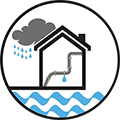At The Damp Specialist Company, we are independent surveyors. We don’t sell or install treatments. Our role is to investigate, explain and specify proportionate, fabric-compatible actions so you can brief your chosen contractor with confidence.
What Each Term Really Means
- Condensation: moisture from indoor air turning to liquid on colder surfaces when the surface temperature falls below the air’s dew point. Often seasonal and linked to room use.
- Damp (as a catch-all): unwanted moisture in building fabric from sources such as rain penetration, capillary uptake from the ground, plumbing leaks, or trapped moisture. Condensation is one type of damp problem, but many people use “damp” to mean rising or penetrating issues only.

How They Typically Present
Condensation
- Water beads on glazing, cold corners, metal frames, uninsulated lintels
- Patchy mould on cold surfaces (external corners, behind furniture, north-facing walls)
- Worse after showers, cooking, laundry, or at night with windows shut
- Improves with steady ventilation, source control and gentle background heat
Penetrating Damp (Rain/Leaks)
- Localised wet patches after wind-driven rain
- Staining beneath defects: cracked render, failed pointing/flashings, leaking gutters, porous sills
- Can occur at any height, often near junctions or external cracks
Rising Damp / Ground Moisture And Bridging
- Low-level band within the first 1 m of wall
- Paint blistering, salts crystallising, skirting decay
- Worsens where external ground is high, plinths are cemented, or floors/walls are bridged
Plumbing Leaks
- Sharply defined damp near pipes, bathrooms, kitchens
- May be warm to the touch or continuous regardless of weather/season
Hygroscopic Salts
- Salty, slightly sticky feel; wall “feels damp” in humid weather even if liquid water is absent
- Often where historic ground moisture or chimneys have loaded the plaster with salts
Quick Tell-Tales You Can Check Today
- Time and trigger: if it worsens overnight, after showers, or when drying clothes indoors, think condensation
- Pattern: a neat low band with salts points to ground moisture/bridging; random patches around cracks or sills point to rain ingress
- Surface temperature: noticeably colder than adjacent zones suggests condensation/thermal bridging
- Weather link: appears after storms or wind from one direction, consider penetrating damp
- Salts: fluffy crystals or tide marks signal ground-derived salts; condensation rarely leaves a soluble-salt band
- Materials: impermeable paints, cement pointing, vinyl wallpapers and sealed floors can trap moisture from any source

Why Older Buildings Are Different
Traditional fabric (lime mortars, soft brick, timber floors, lime plasters) is designed to breathe. Blocking breathability with cement, dense renders and plastic paints can convert small, manageable moisture loads into visible damp problems. Newer buildings rely more on barriers, cavities and membranes, so failure modes tend to be detailing gaps, interstitial condensation or service leaks. The right remedy depends on which world your building belongs to.
Our Survey Method In Brief
- Moisture mapping by mode and pattern, not just single meter readings
- Temperature and humidity profiling to understand dew-point risk and thermal bridges
- Sub-floor ventilation checks where timber floors are present
- Selective salts testing where low-level staining is ambiguous
- Fabric-compatibility audit to find breathability breaks and bridging points
- Clear, prioritised recommendations that address causes first

Actions That Actually Help (Cause-Led, Proportionate)
If It’s Mainly Condensation
- Reduce moisture at source: lids on pans; extractor fans ducted outside with overrun; avoid indoor drying or create a dedicated laundry zone
- Increase controlled ventilation: trickle vents; properly ducted fans; balanced whole-house systems where appropriate
- Improve temperature balance: gentle continuous heat; address cold bridges (lining/insulation details) without trapping moisture
- Keep finishes vapour-open where possible, especially on traditional walls
If It’s Mainly Rain Or Leaks
- Repair gutters, downpipes, flashings, window junctions; re-form drips and throatings
- Repoint in lime where masonry is soft/old; avoid dense cement that traps moisture
- Check sills, render cracks, parapets and coping stones
If It’s Ground Moisture Or Bridging
- Lower or separate external ground at wall bases; introduce drainage margins where appropriate
- Remove cement plinths and impermeable coatings that straddle the wall base
- Ensure suspended floors have cross-flow ventilation; avoid sealing former voids with solid floors that drive moisture sideways
If Hygroscopic Salts Are The Driver
- Once causes are addressed, manage residual salts with breathable, salt-tolerant plasters or sacrificial layers; avoid standard gypsum on salt-loaded backgrounds
When To Call Us
- Mould or streaming windows in winter and you’re unsure if it’s “just condensation”
- Persistent low-level staining despite repainting and dehumidifiers
- Damp patches that correlate with wind-driven rain or follow external cracks
- Planned works on a period property where independent advice is needed before committing
Our Approach
We are independent and carry out no remedial works. We diagnose first, explain clearly, and specify proportionate, fabric-compatible measures that a contractor can price and deliver. That separation keeps advice impartial and your building healthier for the long term.



